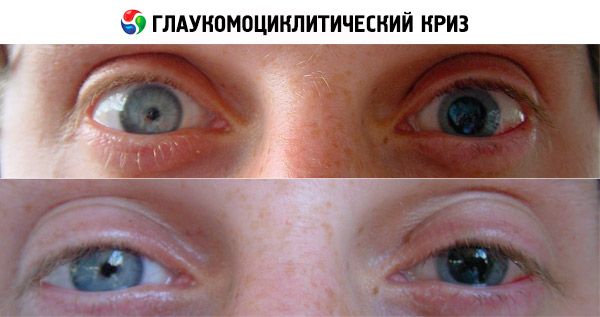Medical expert of the article
New publications
Glauco-cyclic crisis (Posner-Schlossman syndrome)
Last reviewed: 18.10.2021

All iLive content is medically reviewed or fact checked to ensure as much factual accuracy as possible.
We have strict sourcing guidelines and only link to reputable media sites, academic research institutions and, whenever possible, medically peer reviewed studies. Note that the numbers in parentheses ([1], [2], etc.) are clickable links to these studies.
If you feel that any of our content is inaccurate, out-of-date, or otherwise questionable, please select it and press Ctrl + Enter.
Glauco-cyclical crisis is a syndrome that manifests itself as repeated episodes of light idiopathic unilateral non-granulomatous anterior uveitis in combination with a pronounced increase in intraocular pressure.
The syndrome was first described in 1929, but it was named after Posner and Schlossman, who described this syndrome in 1948.
Epidemiology
Glauco-cyclic crisis is usually detected in patients aged 20-50 years. In the overwhelming majority of cases, the process is unilateral, although cases of bilateral lesion have been described.
Causes of the glauco-cyclical crisis
The cause of the development of glauco-cyclical crisis is unknown. It is believed that the increase in intraocular pressure occurs as a result of a sharp violation of the outflow of intraocular fluid during exacerbation. It has been shown that prostaglandins play a certain role in the pathogenesis of this disease, since their concentration in the intraocular fluid correlates with the level of intraocular pressure during the attack. Prostaglandins break the blood-watery moisture barrier, as a result of which proteins and inflammatory cells enter the intraocular fluid, its outflow is disturbed, and the intraocular pressure rises. In some patients with glauco- cyclic crisis, a violation of the dynamics of intraocular fluid and between episodes of the disease, sometimes background primary open-angle glaucoma, is observed.
Symptoms of the glauco-cyclical crisis
A history of these patients - recurring episodes of mild eye pain or discomfort and blurring of the image without signs of vascular injection. Some patients also complain of rainbow circles around light sources, which indicates corneal edema.

Course of the disease
Posner-Schlossman syndrome - self-sustaining ocular hypertension, resolved spontaneously, regardless of treatment. Inflammatory attacks are repeated at intervals of several months to several years, and their duration ranges from several hours to several weeks to spontaneous resolution. Damage to the optic nerve and the appearance of visual field defects in glauco-cyclical crisis can occur as a result of repeated episodes of marked increase in intraocular pressure with concomitant primary open-angle glaucoma.
Diagnostics of the glauco-cyclical crisis
An external ophthalmologic examination often does not reveal any pathology. When examining the anterior segment, several precipitates are usually detected on the endothelium of the lower cornea. In some cases, especially with a sufficient increase in intraocular pressure, it is possible to observe corneal edema in the form of microcysts. Sometimes corneal precipitates are detected by gonioscopy, which indicates the presence of trabeculitis. In the fluid of the anterior chamber of the eye is usually a small number of inflammatory cells, it is slightly opalescent. With a significant increase in intraocular pressure, a slight dilation of the pupil can be observed, but peripheral anterior and posterior synechiae are not formed. Rarely observed heterochromia, which develops as a result of atrophy of the stroma of the iris with repeated unilateral inflammatory attacks. Intraocular pressure is usually much higher than expected with such activity of intraocular inflammation, usually greater than 30 mm Hg. (often 40-60 mm Hg). Changes in the fundus usually does not occur.
Laboratory research
Diagnosis of glauco-cyclical crisis is carried out on the basis of clinical data. Laboratory studies to confirm the diagnosis does not exist.
Who to contact?
Treatment of the glauco-cyclical crisis
Treatment for Posner-Schlossman syndrome begins with a topical application of glucocorticoids in order to control anterior uveitis. If, in response to anti-inflammatory therapy, there is no reduction in intraocular pressure, antiglaucoma drugs should be prescribed. Prescription of mydriatics and cycloplegic drugs is usually not required, since spasm of the ciliary muscle is not characteristic of the syndrome, and synechiae are rarely formed.
It was shown that oral administration of indomethacin, a prostaglandin antagonist, at a dose of 75-150 mg per day, resulted in a more rapid decrease in intraocular pressure in patients suffering from glauco-cyclical crisis than with standard antiglaucomatous drugs. It should be expected that therapy with local non-steroidal anti-inflammatory drugs will be effective in patients with ocular hypertension.
Miotik and argon laser trabeculoplasty are usually ineffective. Conducting prophylactic anti-inflammatory therapy in the intervals between attacks is not required. The need for operations aimed at improving filtration is extremely rare, and their implementation does not prevent the development of repeated inflammatory attacks.


 [
[